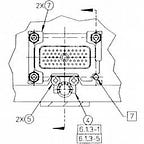The HP 70310A module provides 10 MHz and 100 MHz precision frequency references for HP70K systems using a viberation-isolated ovenized quartz oscillator. A rear-panel 10 MHz input is also provided to allow the 70310A to be connected to a house standard if a higher precision frequency reference from a Rubidium oscillator or GPS-sychronized time standard is avaialble.
When being used as a primary frequency reference, the 70310A allows a 40 volt DC input to be connected, which allows the crystal to remain temperature stabilized even when the HP70K system is powered off. The 70310A can also include one or two independent four-output distribution amplifiers for 10 and 100 MHz signals, which allow multiple modules to be directly connected to the frequency reference.
The 70310A can operate as a stand-alone module, or as a slave module to a 70900A or 70900B Local Oscillator module.
Inside the 70310A
The major components visible on this side are, from left to right:
Oven/Oscillator Assembly
RF Board Assembly
Empty expansion space for a distribution amplifier assembly
The RF board includes a phase-locked-loop (PLL) for the oscillator, and a 10x frequency multiplier to generate the 100 MHz output.
A closeup of the Oven/Oscillator Assembly is shown below:
The oscillator is a OvenAire-Audio-Carpenter OSC 42–21A.
Unfortunately, OAC was acquired long ago, and no datasheets or specifications can be found online.
The black shock absorbers can also be seen in the picture, which prevent vibrations from affecting frequency stability.
The major components visible on this side are:
Power Supply/Processor Board Assembly.
This includes the MSIB interface, power supplies and control interfaces. A second expansion space for a distribution amplifier assembly can be seen at the top left.
The connector in the middle of the rear panel, with the coax labelled “0”, carries 40 volts DC to keep the oscillator temperature constant while the HP70K system is powered off.
Interesting Experiments
Since no specifications appear to be available for the oscillator, a future project may be to determine which pins on the oscillator are used to provide oven power and frequency adjustment, in order to allow these oscillators to be used in other projects.
Since an ovenized quartz oscillator is no longer considered state-of-the-art, replacing this module with a rubidium oscillator module and control board would allow this unit to provide higher frequency stability and quicker stabilization time.
Module Resources
Teardown of a 70310A by Shahriar of The Signal Path blog:
Installation and Verification Manual:
Service Manual:
